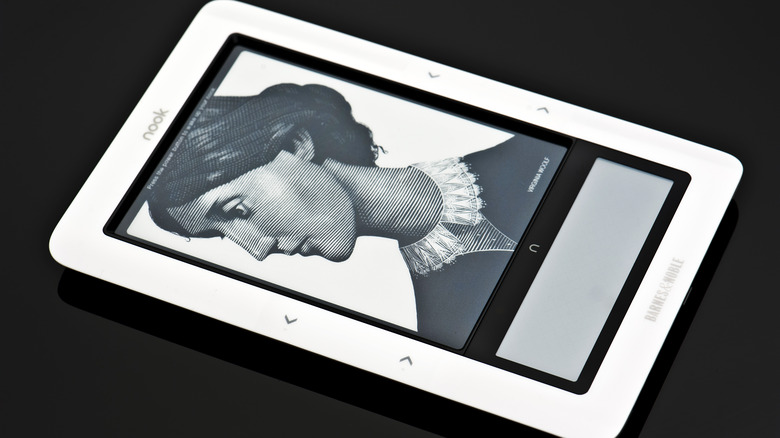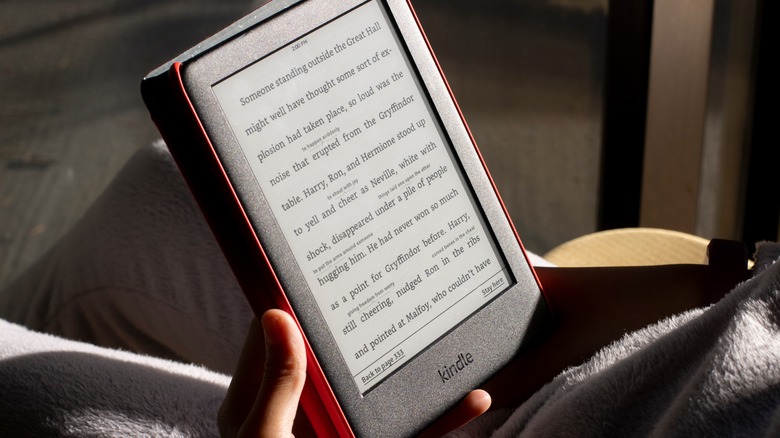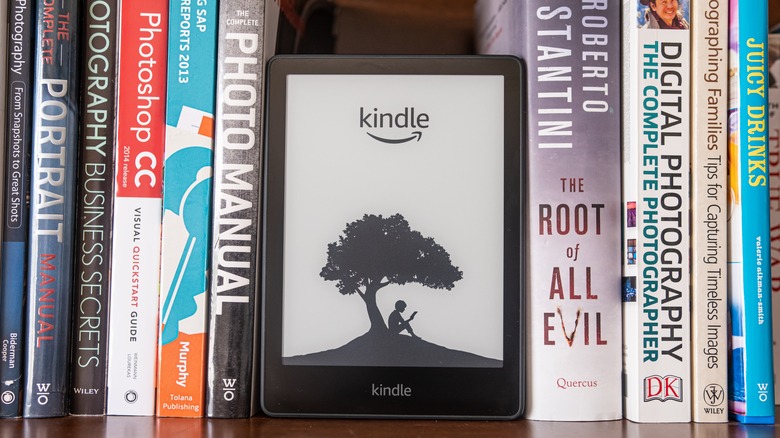Kindle Vs Nook: Which Is The Better E-Reader?
E-readers were once seen as something of a novelty, but they have long since become a staple in the reading community. Hundreds of millions of e-books are sold every year to readers all over the globe. Paper books still make up a vast majority of overall book sales, but the trend towards digital media has been steadily growing. There are a lot of perks to using an e-reader. You can purchase and download books instantly, eliminating the need to go to a store or wait for a delivery. They're lightweight and compact, so they are easy to travel with and take up a lot less space on your shelves. Many of them have special features that allow you to save quotes, adjust font sizes, look up words you don't know, or track reading goals. Many also have built-in backlights, making them great for reading on a plane or in a darkened bedroom after your partner has gone to sleep.
But those thinking about giving digital reading a shot have a pretty big decision to make — choosing what type of e-reader they want to buy. There are a lot of big brands out there, but Kindle and Nook are two of the oldest and most prolific. Each offers several different models of e-readers–each equipped with its own feature set. Here's a little bit of information about the brands and a few suggestions for which one is better.
What is Kindle?
Kindle is one of the first names you'll see when you start looking at the different e-readers available on the market. This is because Kindle is owned by Amazon, which means that it's backed by the single largest online marketplace on the planet. This probably doesn't come as much of a surprise, though. Amazon started as an online book retailer, so it makes sense that the company would have a vested interest in technology related to reading. In fact, much of the current digital literary market was shaped by the corporation.
Amazon released the first Kindle back in November 2007, followed swiftly by the self-publishing service Kindle Direct Publishing. This meant that the company simultaneously established a method of publishing and selling e-books in an online marketplace without needing third parties. Just a few months later, Amazon acquired Audible, giving itself a foothold in selling audiobooks. The first Kindle was a boxy tablet by today's standards, but the design has continued to evolve over the years.
There have now been 11 generations of Kindle, with the most recent coming out in 2022. The company offers an array of models with varying features and price points — all of which have access to every e-book and audiobook available through Amazon and Audible's respective digital libraries. Amazon also offers the Kindle Unlimited subscription service, which offers unlimited access to a curated library consisting of over four million books and thousands of audiobooks and magazines.
What is Nook?
Nook tablets are made by Barnes and Noble. While not quite as all-encompassing as Amazon, Barnes and Noble is easily the largest brick-and-mortar chain of book retailers in the U.S., making it an attractive option for consumers who prefer to buy tech in person. Like Amazon, Barnes and Noble also has its own publishing service and has access to a massive library of titles. The Nook has been around almost as long as Kindle and has undergone quite a few changes over the years.
The first Nook was launched in 2009. It was unique when it first came out as it was the first tablet to combine e-ink technology with an LCD touchscreen at the bottom, allowing users to navigate menus and explore options in full color. Later iterations would add new features like free 3G connectivity and expand the range of size options and feature sets available. Nook is currently offering its fourth generation of GlowLight e-readers, first launched in 2021.
Nook readers can purchase and download any e-books available through Barnes and Noble's considerable digital library and audiobooks if they have a compatible device. Nook does not, however, offer any sort of subscription service.
What kind of e-readers does Kindle make?
The current generation has seven different kinds of Kindle e-readers: the basic Kindle, Kindle Paperwhite, Kindle Paperwhite Signature Edition, Kindle Oasis, Kindle Scribe, Kindle Kids, and Kindle Paperwhite Kids. These typically get larger screens and add features as they go up in price. The standard Kindle is a 6-inch e-reader with 16GB storage. The Paperwhite is 6.8 inches, has a brighter illumination with an adjustable warm light, and is waterproof.
The Signature Edition is the same size as the basic Paperwhite but has 32GB storage, and its backlight auto-adjusts to the ambient lighting of the room. The Oasis is a 7-inch tablet with most of those features but is even brighter and has automatic page rotation, page turn buttons, and cellular connectivity. At the same time, the Scribe is 10.2 inches, can do nearly all of that, and doubles as a note-taking tablet. The Kindle Kids tablets have built-in cases with bright, colorful designs curated, distraction-free reading for kids. They're ad-free and come with a one-year subscription to Amazon Kids+.
The early Fire tablets used to be considered an extension of the Kindle line too, but Amazon dropped the Kindle name from them years ago. They have e-reader capabilities, but they use a normal backlit color LCD screen instead of the e-ink displays used by e-readers. They also have access to a wide array of apps through the Fire Tablet App Store, which grants them access to games, streaming services, and a variety of other forms of utility and entertainment. This makes them more akin to an iPad than a tablet designed explicitly for reading.
What kind of e-readers does Nook make?
There are four different models of e-reader in Nook's current lineup: The Nook GlowLight 4e, Nook GlowLight 4, Nook GlowLight 4 Plus, and Nook 10" HD Tablet. Like with the Kindles, these typically get larger and offer more features as they go up in price. The Nook GlowLight 4e and GlowLight 4 are both 6-inch e-readers. Both are lightweight tablets with identical dimensions and backlighting. The GlowLight 4e is a cheaper model designed to give Kindle some affordable competition.
The Glowlight 4 has a few extra features, though. To start, it has a 300-ppi (pixels per inch) screen, which matches the resolution on Kindles, while the 4e only has 212-ppi. It also has a special 'Night Mode' lighting feature that is supposed to be easier on the eyes when reading in darkness. The 4 Plus has a 7.8-inch screen, supports audiobooks, and has a headphone jack and Bluetooth connectivity options for connecting to speakers or headphones.
Finally, there is the Nook 10-inch HD tablet, which Barnes and Noble designed in a collaboration with Lenovo. This is more like the Fire. It features a full IPS LCD color display rather than e-ink screens used by tablets designed exclusively to be e-readers. It also has full access to the Google Play store.
Winner: Kindle
The Kindle and the Nook are excellent devices with access to massive digital storefronts for readers. That said, the Kindle beats the Nook in almost every arena. Some of the Barnes and Noble e-readers are a bit cheaper than their Amazon counterparts, but the difference in overall value is significantly weighted in Kindle's favor. The GlowLight 4e, for instance, is $10 cheaper than the basic Kindle, but it has a lower resolution, half the storage capacity, and lacks the Kindle's Bluetooth connectivity features for listening to audiobooks.
E-book pricing between the two storefronts is nearly identical, with each occasionally undercutting the other by a matter of pennies. Still, it's hard to deny that Amazon offers a lot more options. The Kindle Unlimited and Audible subscription services offer unique ways for readers to get unfettered access to massive libraries of digital literature. Plus, Barnes and Noble simply don't have a comparable alternative. There are also a lot more varieties of Kindle, offering a wider range of sizes and feature sets.
One feature that might turn readers in the Nook's favor is the fact that its e-readers have larger bezels and buttons on the side of the tablet for turning pages, while most of the Kindle models use touchscreen functionality. This isn't a pro or a con but rather a personal preference. Of course, there will also be those who might want to buy a Nook simply to avoid giving more money to Amazon.





